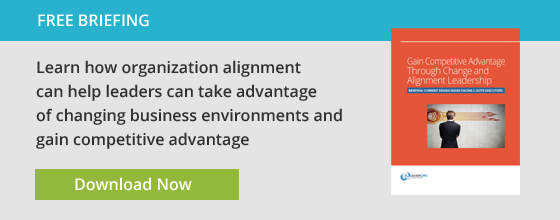We all want quicker results. The faster we can implement our strategy the sooner we can reap the rewards and respond to shifting marketplace demands. But those involved in any strategic change initiative like an organization redesign or business model change know that speed is not easy to achieve. Strategic change is often met with a mix of enthusiasm and excitement as well as skepticism, apprehension, and doubt. The fundamental question members of the organization are asking is “what does this change mean for me?” While many changes might mean positive things for organization members, just the uncertainty about what the change means can slow efforts to implement, optimize and realize benefits. Despite the best change management efforts, strategic change often requires more time and effort than leaders are prepared or willing to give.
So what can you do to speed the time to results? Here are some of the best ways to speed up your strategic change implementation in order to more quickly realize the benefits of strategic change.
Break work down into smaller chunks. Some leaders want to jump right in and change everything—tackle the monster as it were. Others are more cautious and methodical and want to evaluate how much, if any, change is needed. Often, both philosophies are in the room at the same time trying to shape the scope, size and pace of strategic change.
Regardless of which philosophy prevails, you can accelerate the pace of change when you break the problem down into manageable chunks that can be defined, designed, communicated, and implemented in a finite time period. Such a work chunk helps the organization feel like progress is happening and leads to measurable results faster than waiting until everything may need to change. More often than not, organizations find that getting moving on a piece of the change can create the momentum needed to start and maintain the drive towards a large-scale, strategic change. Rather than try to solve every problem all at once, agree on one problem and solve for it.
Parallel process. Not all strategic implementation activities can occur simultaneously. However, you can drastically increase your implementation speed by looking for activities that you can execute at the same time.
For example, as part of our design process we generally work with executive leadership to set the strategic vision, business model, and macro organization design. After executive leadership does this work, we conduct multiple “micro-design sessions” that focus on more specific work processes, structure, roles, and incentives. For these micro design work streams, we involve other members of the organization besides the executive team. It is also possible to facilitate multiple micro design sessions simultaneously. Running these sessions concurrently puts little additional stress on the organization and speeds up the implementation process. Similarly, finding strategic implementation tasks that you can execute simultaneously can speed up the implementation process.
Dedicate and focus resources. Despite the excitement and additional work surrounding the implementation of a new strategy, leaders still have their day jobs to do to keep the business running. As a result, leaders try to balance their implementation responsibilities with their daily work. While no one wants to be too overwhelmed, this balancing act can prolong a strategic implementation and cause a loss in momentum.
The solution to this problem can come from dedicating resources to perform the implementation work. After completing an implementation, we often hear leadership say that in retrospect that they wished they would have dedicated resources to the change efforts rather than lose momentum by trying to balance their regular daily work load. Think of it as “ripping the Band-Aid® off” rather than slowly implementing their design. By dedicating resources, we have found that businesses can stand up their strategies quicker and reduce the stress on their organization caused by prolonged, slow change.
Focus on a few critical changes. Another way to increase your implementation speed is to focus on the critical few changes. A number of years ago, we worked with an HR organization that was struggling to meet their commitments. Their leaders had so much on their plates that they spent their days moving from one meeting to the next giving updates on the myriad of projects and initiatives they had on their plates. We soon discovered that the group never said “no” to anything and as a result their workload never stopped growing.
This same mentality creeps into implementation efforts. Often organizations get bogged down because they are trying to do too many things at the same time. Focus your efforts on a critical few things that will deliver the greatest strategic benefit and let the rest wait – better to get three things done and implemented that have 15 things in flight.
Know who your champion or “agitator” is. The most successful changes we have seen over the years have had a champion driving the work forward and refusing to let current organizational inertia prevent progress. These “agitators” constantly push for the change, hold the organization accountable, and motivate others along the way. They imbue and reiterate the attitude of “we are doing this” and “you can do this.” A good change champion is essential if you plan to quickly implement a strategy. Without one, the impetus for making tough changes lacks and will slow efforts to move forward.
We all want to implement our strategic changes faster, and you can! Much like a good strategy or organization alignment, increasing your implementation speed requires conscious effort, planning, and at times an external change partner. However, with the right tools you can implement your strategy quicker and as a result realize desired marketplace success.






